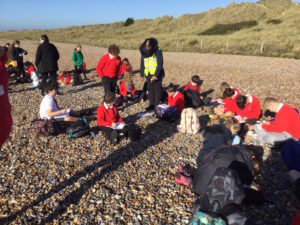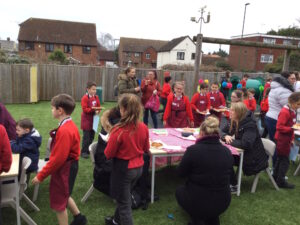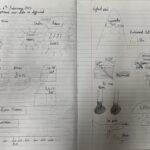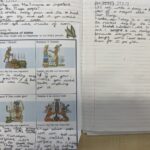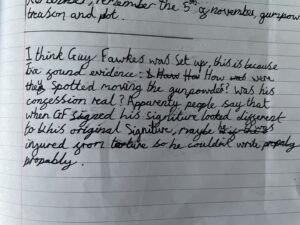Humanities
Geography
What is this curriculum trying to achieve, and how does this relate to our overall aims and ethos?
At Lyminster Primary we aim for our Geography curriculum to be a subject packed with excitement where children learn about different aspects of the world and helps them to better understand its people, places and environments, and the interactions between them. We believe this will help them become Rights Respecting citizens, as they grow to understand why children and communities around the world have different lives, opportunities and challenges. We also want to continue to feed their natural curiosity about the world, to foster a life-long love of learning.
We want our children to understand how and why places are changing, and to see Geography as a living, highly relevant subject at the heart of the great, interesting debates of the day. For example; when Year 3 study the Rainforests they can see how changes brought about by humans are affecting climate, the environment and the living things within it but also how the lives of human beings are being affected by these changes. We seek to develop enquiring minds and consider it imperative that children don’t just answer questions but also ask and debate them – giving them confidence to state their case as geographers and active citizens. Years 4 and 6 work together on a cross-phase topic to make a positive change in the world around us, and engage our community, using their geography learning. Within topics about the wider world, such as the year 5 topic ‘Are Rivers Still Important’, children will be encouraged to do their own research and learn about these environments and the changes taking place.
In both key stages, children have the opportunity to study our locality and see the changes that have happened in their own area, why they have happened and how this has changed the way people live – giving vital context to the Community Spirit we aim as a school to imbue. Year 4’s work on how the locality has changed over time gives inspiration and models to Year 2’s topic on ‘Lyminster and its Dragons’. Reception and Year 1 in particular make fantastic and very ‘hands on’ use of our local geography when they visit both the sea and the local woodlands as part of the ‘Let’s Go Outside’ and ‘The World in Our Hands’ topics.
How is the curriculum actually implemented – how do we ensure progression, retention, and what does teaching and learning in this subject actually ‘look’ like?
We follow the National Curriculum, breaking these objectives down further (as can be seen below) into incremental yearly steps so that children can consolidate and build upon previous learning. To help the children see the relevance and importance of Geography, it is usually taught within the context of a cross-curricular topic, however the objectives are used to ensure subject integrity is maintained and the children are being taught to be geographers, as opposed to learning ‘about a country’, for example. Strong links are made with History – units on historical civilisations will typically begin with looking at the geography of theat civilisation and how that contributed to its rise, such as when we look at the importance of the Nile Delta to the Ancient Egyptians – but also with Science (in studying the natural world) and Music and the Arts (with our globalised focus as a school on our cultures).
Geography lessons usually begin with questioning and discussion to reactivate their previous learning, and short thinking-skills activities such as rapidly discerning some geographical similarities and differences from two photographs cue the children into the styles of thinking required. Units are planned to enable to children to be as active as possible in their learning: children have the opportunity to take part in local fieldwork where appropriate, study maps (including digital maps) and photographs, particularly at the beginning of each unit, and engage in debates or research.
We take advantage of global events such as sporting World Cups or Eurovision etc to feed the children’s curiosity and general knowledge about the world and its continents/countries, in line with feedback from our local secondary school on what would most support them in making the progression to the Key Stage 3 programme of study and beyond. To support raised achievement in GCSEs, again based on their feedback, we are mindful of pushing and supporting our core and more able students to develop their reasoning and explanations into more structured and longer pieces of writing where this is appropriate. We will make use of English time and longer writing journeys to link with Geography objectives in a Geography-led topic, for example.
Broadly speaking, and as can be seen in the Progression Overview, we start in the earlier years being much more immediate and concrete in terms of linking to the children’s personal experience (such as the beaches and woodlands near the school), moving towards more abstract and complex learning in Key Stage 2, for example looking at how population and land use in Japan has changed over time and how this might link to the events of the 20th century. Each class has a ‘link country’ which they study and compare with Britain in depth. Throughout their 7 years, this gives the children an understanding of very different countries from all continents around the world.
How is this curriculum adapted to meet the needs of different children and groups of children, particularly those with SEND?
Any relevant support included in the ILPs or EHCPs of children with SEND will also be in place in Geography lessons as far as is practicable. Cognitive load is reduced where helpful through limiting the scope of (eg) maps, and scaffolding of written tasks for example through sentence stems or heavier frames, children may also give verbal responses where a written response may take their cognitive focus away from the geography. Processing time is increased with extra time for further discussion in small groups and with an adult, and extra visual resources/prompts may be provided. Where possible and helpful, the task and focus may be adapted to make it more concrete and relevant to the child’s personal experience. In the rare event that a child may not be developmentally able to access an objective at all, we will go back to the previous programme of study to reinforce these building blocks for learning, and/or bring learning about the world into their alternative provision, for example through our Forest School curriculum.
How is progress against, and retention of, this curriculum assessed? How are any gaps in learning then addressed?
Key pieces of work are identified in the Progression Overview and the Long Term Plan, which are identified for assessment of whether the children have met objectives for the unit. Whether children continue to meet these objectives over time forms the basis of a summative judgement on whether the children are on-track for meeting age-related expectations at the end of their Key Stage. This summative judgement is made formally once a year and reported to parents. The children’s achievement in Geography is also discussed at the end of the year when handing over verbally to the next class teacher, to identify gaps which need to be addressed in the Autumn Term of the following year – this could be through re-teaching or emphasising certain aspect which we know to be weaker. Quizzing, and referring back to previous units to make links, are used to repeatedly reactivate prior learning and promote retention. The children’s responses to these quizzes and discussions are also used formatively by the teacher.
History
What is this curriculum trying to achieve, and how does this relate to our overall aims and ethos?
We show belief in the children, and inspire their confidence, through a disciplinary and enquiry-based approach that encourages them to see themselves as Historians. ‘Debate’ is key to this, and can be considered the underlying theme of our History curriculum. We also add cultural capital through visits and links, eg to Butser Farm where they can experience Anglo-Saxon life ‘hands-on’, or Preston Manor for immersion into a Victorian household. These experiences aim to give awe and wonder, and inspire a lifelong love of History learning. Topics such as ‘We Can Be Heroes’, and our focus in Assemblies through Black History Month, aim to develop empathy and respect through the prism of history.
How is the curriculum actually implemented – how do we ensure progression, retention, and what does teaching and learning in this subject actually ‘look’ like?
We follow the National Curriculum, and use Key Stage History as a starting point to our planning of units as this supports the enquiry based approach, with Key Questions underpinning each lesson and room for the children to form and then communicate their own, evidence-based conclusions. Children are given opportunities in every lesson to discuss and justify their ideas, and debate is encouraged, for example when the children in Year 6 decide whether Guy Fawkes was guilty or innocent based on the evidence they have, and extend this learning to explore the theme of democracy and attacks on democracy more widely. Teachers augment by using a variety of techniques to make the learning relatable and interactive, such as using artefacts, museum visits either real or virtual, videos and other sources, or even teacher- or child-in-role. Lessons usually begin with a quick thinking-skills activity to cue the children into being historians, such as looking for evidence in a topic-related picture.
The curriculum is carefully sequenced in terms of knowledge (chronology, and the characteristic features of each time period), understanding (cause and consequence, and change and continuity), and skills (enquiry, interpretation and communication), as you will see below. The youngest children begin with exploring history through stories and traditional tales, before starting to link this with their own concrete experiences and those of their families, for example seaside holidays now and then. They also explore the history of the local area they will be very familiar with, for example when they visit Arundel Castle and explore life as a medieval knight through role play and storytelling. As they go through the school, the children will begin to study less familiar time periods and more abstractly, for example the Stone, Bronze and Iron Ages in our ‘Long, Long Ago’ topic. By the time they reach upper school, they are expected to be able to consider and debate complex issues, such as whether an invasion can ever be considered a positive thing, and to answer these sorts of questions by making links between different topics, such as when they studied Ancient Rome and separately the Vikings.
Retention of the curriculum is promoted through this sort of discussion where the teacher can prompt the children on prior learning and make links explicit. Quizzing is also used as an engaging way for the children to recall prior knowledge across and between units.
How is this curriculum adapted to meet the needs of different children and groups of children, particularly those with SEND?
Some children will benefit from further group discussion before starting a task, particularly where the teacher or an adult can model certain ways of thinking by ‘wondering aloud’; they may also benefit from ‘bouncing around’ ideas with peers for longer. Sentence stems may be used to scaffold written or oral tasks. Where particular support is identified on ILPs or EHCPs that are applicable across the curriculum, these will also be in place during History lessons. For some children with SEND, some aspects of the curriculum may be too abstract for them to fully access, in which case the adults will adapt the task to link the objective to more concrete or personal experiences for that child, or to particular interests they may have. In a very, very small number of cases, the child may not be able to meaningfully access the abstract learning of particularly the Key Stage 2 curriculum at all, in which case we will take the approach taken in Key Stage 1 of using role play and story-telling to support imaginative links and give as much access as possible – we will also make links to History through any alternative provision identified in their individualised plans, for example through comparing desserts enjoyed now and in our Grandparents’ youth when baking.
For children who grasp the concepts more quickly, they are required to justify their ideas in more depth, including through making more links with other time periods, giving multiple reasons or anticipating counter-arguments. This is achieved through adaptation of the task or frame presented to them, and/or through teacher ‘bounce-back’ questioning.
How is progress against, and retention of, this curriculum assessed? How are any gaps in learning then addressed?
Key tasks are identified in the long term planning below which offer opportunities to assess the children’s understanding and grasp of the concepts. Where gaps in learning are identified, these are then followed up with the whole class, or with groups or individuals, ideally in the moment through teacher intervention or plenary, or alternatively in subsequent lessons and through adaptation of future plans. In the Spring Term, the teachers make a summative judgement of each child’s level of mastery of the National Curriculum content, which is shared with their parents/carers. Any persistent gaps in learning are shared verbally with their next teacher in our ‘Handover Meetings’ at the end of the summer term, to inform future planning also, for example through repeating or emphasising certain key skills.
Teachers’ professional judgement is based on the progression of knowledge, understanding and skills given below, which then give learning intentions for each lesson based on which teachers can make a series of ‘can they/can’t they’ judgements formatively, by comparing the objectives with the children’s responses to the tasks. An exemplification file of children’s work is also stored on our drive which teachers refer to when making summative judgements, as a form of standardization.
Links

